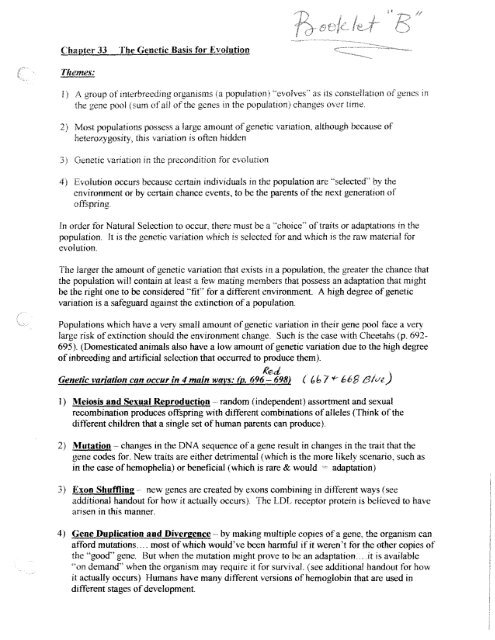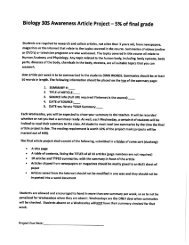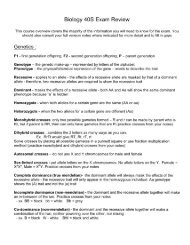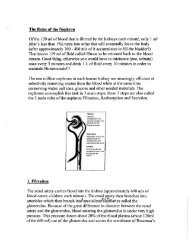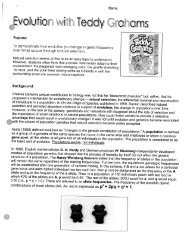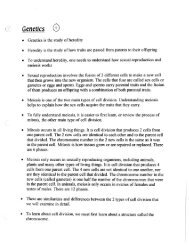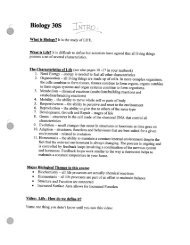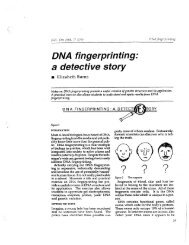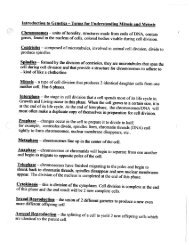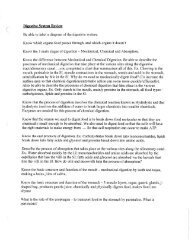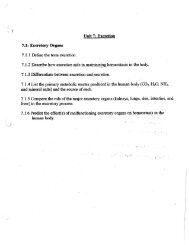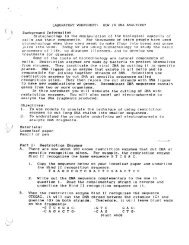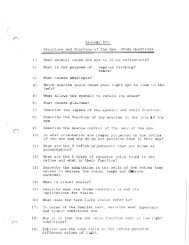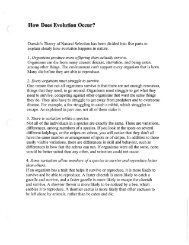Genetic Basis for Evolution Booklet B.pdf - Mrs Stovel
Genetic Basis for Evolution Booklet B.pdf - Mrs Stovel
Genetic Basis for Evolution Booklet B.pdf - Mrs Stovel
Create successful ePaper yourself
Turn your PDF publications into a flip-book with our unique Google optimized e-Paper software.
3.s fiveBoth of the "extremes are selected <strong>for</strong>, the "average" is selected against,ex. mimicrybutterfliesGiven:3 separate speciesspecies I Bad tasting to birds. Birds don't eat them.Survival tactic.Gies 2Bad tasting also,species 3Good tasting to birds, Birds eat them. A problemthat needs to be overcome by another adaptationspecies 3Happens to have 3 naturally occuring variations inthe coloration and patterns on its wings.1. looks like species 1 (homo. recessive)2. looks like neither species 1 or 2 (heterozyg.)3, looks like species 2 (horno, dom.)Birds avoid eating species 3 if they have variation I or 3 but they love to eatvariation 2 because they taste great all of the time!!! (The birds learn to avoidvariations I and 3 because sometimes, they taste redly bad). In this case, thebirds.have acted as a selective agent. Because the birds avoid eating thebutterflies which mimic the coloration of other, perhaps unrelated distastefulbutterfly species, the other species of tasty butterflies has gained an adaptiveadvantage. The 2 "extremes" have been selected <strong>for</strong> while the "average" hasbeen selected against.d ^ i n e ` er or
The Founder EffectEl ETIC DRIFTAz, important as natural selection is Linder certain circutns€ances,both field and theoretical studies in populationgenetics have shown that it is not the source of all changein gene frequencies in natural populations. It is possible<strong>for</strong> a mutation to become common in a population entirelyby accident through a phenomenon called geneticdrift. Even a harmful mutation can become established,and can remain in a gene pool, as long as a single copy ofit is not lethal.Operating by chance, genetic drift works moststrongly in either small populations or populations of dramaticallyrising and falling size. When a nonlethal mutationoccurs in such a population, it is possible <strong>for</strong> theorganism carrying that mutation to have more offspringthan its neighbors not because it is better adapted, butjust by chance.Also, a sudden change in the environment of thatpopulation may just happen to wipe out many of the individualsthat do not carry that mutation. When either ofthese situations arise, a new mutation can appear in mostmembers of the population after only a few generations(Fig. 12,17). In large, stable populations, this is much lesslikely to happen by accident.If a small number of individuals migrate off to found anew population, they may carry alleles in different relativefrequencies from the main population just by chance.This phenomenon, known as the founder effect, is an extremecase of genetic drift, Figure 12.18 offers an illustration.of how the founder effect might work.The founder effect can be especially important inplaces such as the Hawaiian or Galapagos islands, wherepopulations of mainland species may be established by ahandful of stranded wanderers. The tiny gene pool ofthose individuals may not be at all representative of thegene pool of the main population from which they came.Founding populations, there<strong>for</strong>e, can start out with peculiarcollections of alleles.There are several well-documented cases of thefounder effect among small groups of humans whosepractices isolate their gene pool from that of the surroundingcommunity. One example is the Amish communityof Pennsylvania, an orthodox religious group thatwas founded by a very small number of immigrants andallows no Marriage to outsiders. Among the founders ofthe American Amish community was the family of a Mr.and <strong>Mrs</strong>. Samuel King. The Kings happened to carry a recessiveallele that causes dwarfism, the growth of extrafingers, and heart defects in babies homozygous <strong>for</strong> it.Those who are afflicted with this condition usually die ata very earl), age. In the outside world, the frequency ofthis allele is less than I in 1000, but the Kings and theirdescendants had larger families than the others in theirAmish community. Thus, through a combination of thefounder effect and genetic drift, this allele occurs in theAmish population today at the extraordinarily high frequencyof about I in 14.remove 2 or 3at randomseveral timesW0sample I sample 20sample 3b ,6^ib 8 B BFigure 12 .17 This demonstration of genetic drift shows howevolution can occur by chance. The population begins with equalnumbers of A and 8 genotypes. Each type produces identical offspring.in each generation, half of the population dies at ran-(do regardless of genotype. The relative numbers of A and 8sotypes vary randomly until A becomes extinct, not becausef is poorly adapted, but by chance alone.sample 4 sample 5Figure 12.18 A schematic demonstration of the founder effect.Imagine a jar of 1000 jellybeans, containing equal numbers offive colors. If you poured out half of the jellybeans, you wouldprobably find roughly equal numbers of all five colors in yoursample. But if you picked out only two or three beans at random,your sample would be missing at least two of the colors presentin the main population, and you could conceivably end up withthree yellow ones. The same thing can happen with the alleles ina small founding population.
ACTIVITY 2: Changing GeneFrequencies in a Population by<strong>Genetic</strong> DriftAny <strong>for</strong>ce that disrupts the stability of a gene poolis an evolutionary factor. In this activity the specificfactor that will alter the frequencies of genes in apopulation is the size of the population. It is a verysimple activity but the questions that arise from theexercise are excellent,One way in which the frequencies of genes in apopulation can be modified is by changing the sizeof the population. For example, if the number ofrabbits in Australia were reduced from fifty millionto <strong>for</strong>ty million, the frequencies of all genes in thegene pool would be reduced by 20%, Suchchanges in the population are of little importancebecause, as is well known, rabbits could quicklyreplenish or even surpass the lost numbers andreconstruct the tormer gene pool.A different kind of effect begins to appear, it onereduces a population to very small numbers. Thenthe relative frequencies, as well as the absolutefrequencies, may be changed merely by chance,in the same way, It one flips a coin fifty milliontimes, he will get very close to haft heads; but if heflips it only four times, he may very well get headsthree or one out of four trials. When the populationagain multiplies, certain genes may be much less,others much more, frequent.This phenomenon is known as genetic drift. It willbe studied by means of the model gene pool.In this and several later studies we will utilize amodel gene pool consisting of two colors of beansin a bag. Our population consists of some speciesof diploid organism. This organism, like ourselves,has paired chromosomes with two genes at eachlocus. The two genes may be the same ortheymaybe alleles - alternate genes <strong>for</strong> tft sameposition. In our model we shall study only onegene locus, and at that locus there are only twoalleles - red and white.hake the assumption that the organismselation, like ourselves, are crossintr^rbreedfreely. These are impor-°t:ans of the Hardy-Weinberg principle,estigation we shall produce smaila large parent population . Startb' ens and 50 re,d beans in aa nt population.LARGE POPULATIONrn 20 beans from the bag andcan. Draw 4 other beansempty can. The beanscall populations thatparent population,suits in Table 1. Add thesin your class.QuestionsTable 1 ' "' ""Results of <strong>Genetic</strong> Drift Study1. According to the Hardy- Weinberg principle,what proportions of red and white beans wouldyou expect in the derived populations?2. How do the actual results compare with theexpected results?3. Do the results deviate less if you average theresins of all teams?4. In which of the derived populations do theresults more nearly approach the expectedproportions, the 20 bean or the 4 beanpopulation?5, Now do you explain the deviation of yourresults from the expected results?6. Is ft possible by reproducing rapidly, ti":the small derived populations cool..another large population in a singly., clion? How would the large third generationpopulation differ from the largecation?7. In what natural situations, r7 1t a popaa!Ct; :r^:undergo similar fluctua, nns.8, What precautions did y _ u to insure tthe derived populations oducedSMALL f',- ; J L.ATIONCIateria4(per team)1 bag of 50 red beans1 bag of 50 white beans2 empty cans
g- 73 W: -^in a,in n <strong>Genetic</strong> aria it t. 709, a b ecdyes . e & 2.^In the absence of outside <strong>for</strong>ces, the frequency of each allele in a populationwill NOT change as generations pass".This is called the Hardy- ileinberq Equilibrium and it suggests that evolutionwill not occur and that a population gene pool will remain constant over time.It also helps to explain why both dominant and recessive alleles can remain in agene pool generation after generation. That is, why dominant alleles don'tautomatically drive out the recessive alleles.There are 5 conditions (outside <strong>for</strong>ces) which must occur in order <strong>for</strong> thefrequency of alleles in a population gene pool to remain constant and thus <strong>for</strong> noevolution to occur:1) No Natural Selection2) No Mutation3) No Gene Flow4) No Nonrandom Mating (Random Mating)5) No Small Populations (Large Populations)The H.I. Principle provides a "benchmark" <strong>for</strong> scientists to use when they aretrying to see if evolution has occurred in a certain population , as well as howmuch evolution has occurred.Recall, the above 5 conditions are the agents of evolution .. ..the things, that whenthey do occur (as opposed to when they do NOT occur), will cause evolution.Scientists who study populations in terms of their gene pools ,time, one of two things can happenwill find that. over1) the population gene pool can remain unchanged (in equilibrium)2) the population gene pool can change (evolve)The Hardy-Weinberg Principle is a mathematical model which can be used tohelp scientists figure out whether a population gene pool has remained stable orwhether it has evolved.The Hardy-Weinberg equation is : p2 + 2pq + q2 v I(where "p" represents the dominant allele <strong>for</strong> a trait and "pz" represents thehomozygous dominant genotype, "q" represents the recessive allele and "q2represents the homozygous recessive genotype, and 4pgm represents theheterozygous genotype).
and -mein cation the fofovimRecall that <strong>for</strong> any given Mendelianrecessive allele. The gene poofrom all members, both" as' and 'a,s" from theexpressed mathematiMales(A a)Vernalhems in a population)Usina the Equation:0 Given the following in<strong>for</strong>mation:The frequency of the dominant allele <strong>for</strong> a trait is 60% (so p = 0.6) and thefrequency of the recessive allele is 40% (so q = OA). What is the % ofindividuals from this population who are expected to heterozygous?Homozygous dominant? Homozygous recessive?P2 + 2 + q2 = 1(.6)2 + 2(.6)(.4) + (e4)2 = 1Homozygous dominant :(^6)2= .36 x 100% 36%• lornozygous recessive : (.4)2 = .16 x 16%• Heterozygous : 2( .24) 48%• See the additional handouts on ^ Population Equilibrium' and "<strong>Evolution</strong>aryChange" <strong>for</strong> more in<strong>for</strong>mation and more examples of how the H.W. Principle isused.
.. Figure 28.2What is unusual aboutthese feet?EVOLUTIONARYCHANGEA population gene pool is very unstable.It is constantly influenced by external fac--tors----factors that were intentionallyignored by Hardy and Weinberg. Thesefactors change a rpopularion's geneticmakeup, upset the tendency towardgenetic stability, and lead to evolutionarychange.-Factor, that brie about evoluri achange are mutation, genetic drift, andmigration. e«ene flow). While each ofthese factors may not be acting equally atall times, each is important in certain circumstasa.ces.MutationMutations are changes inthe genetic makeup of an.organists and occur in a cellas it undergoes meiosis to<strong>for</strong>m an egg or sperm.Mutations can be one oftwo types: chromosomemutation or gene mutation. In cbromosomemutation, the resulting gamete willeither lack a particular chromosome orgain an extra one. Down syndrome, <strong>for</strong>example, is caused by an extra copy ofchromosome 21. The second type ofmutation, gene mutation, results from achemical change inside an individualgene. This mutation type occurs whenthere is rearrangement of or damage tobases in the DNA molecule. Gene mutationsmay cause such serious illnesses assickle-cell anemia, cystic fibrosis, andTay-Sachs disease.sutations, or genotypic variations, arethe raw material <strong>for</strong> evroluti:on. There isgeneral agreement among scientists thatmutations are the original source of vTariawtionand that they have been accuniulatiF.€g<strong>for</strong> billions of years. Yet studies ongene Mutations in diverse organisms suchas bacteria, corn, and humans Indicatethat mutations are rare events <strong>for</strong> anyeven gene. Estimates suggest that mutationrates may he on the order of one perhalf .million. genes per generation. Someresearchers believe that a higher mutationrate might have the effect of losing thevariation be<strong>for</strong>e natural selection has theopportunity to act on it. Nevertheless,because each individual contains manygenes, and because there are so manyindividuals in a population, it is safe toassure that new mutations occur in eachgeneration.As genes are paired, mutations resultingin recessive genes may remain"masked" in the population <strong>for</strong> long periodsof time without affecting an organism'sphenotype. In thisway, a gene that might beharmful can remain in thegene pool. If environmentalchange occurs, theharmful gene might laterturn out to have a selectiveadvantage.Mutations, in and of themselves, areneither good nor bad. Amutation consideredbeneficial in one environment maybe detrimental in another environment.Many mutations are neutral, and have noeffect. Other mutations, with long-rangingeffects, can be harmful and oftendeadly.<strong>Genetic</strong> Drift<strong>Genetic</strong> drift, also called "'random geneticdrift," explains the disruption of thegenetic equilibriixm in small populations.(Remember, the Hardy-Weinberg principleapplies only to large populations andis based on the laws of probability ratherthan natural. selection.) For example, considera population of to guinea pigs, inwhich only one member displays an alleledesignated B <strong>for</strong> black coat color. If, bychance, the black individual does not604Clair 1iyIY.tr7n m! d,I ill.a
mate the black allele will disappear from 8 Describe the two main catecories oftht: popularion (assuming that geneticdrift is the only evolutionary factor atThis situation would change thegene frequencies in successive generaof the Population.Mig7wtian (Gene Flow)Migration is another way in which variationsoriginating within a populationbecome distributed. Movement of membersof a species into (immigration) or outof (emigration) a population alters itsequilibrium. In immigration, new genesare added to the existing gene pool; inemigration, genes are removed.Consider a population of squirrels withred fur color. The population has its owncharacteristic gene pool. If a group ofbrown-colored squirrels of the samespecies is introduced into the same area,the frequencies of the genes will changebecause a new set of genes is added fromoutside the population. The genetic equi--librium is upset, and the gene pool of theoriginal population changes.DO 0 REVIEW QUESTIONS1^V 23What is the main source of variationin living organisms?How would you define a gene pool?Why is population sampling a usefultechnique in studying populationgenetics?4 What purpose does a pedigree chartserve in tracing particular genetic7traits ? Give an example.What prediction does the Hardy-Weinberg principle make with respectto populations?6 Why does the Hardy-Weinberg principleapply mainly to large popula-Lions?What are three factors that may bringabout evolutionary change?Ctn. &m 5)tee. 0 4 ex °--SQUARE TESTPhrases such as "the luck of the draw" and,se are the odds" attempt to describe,crimes of chance events such astosses, dice throws, and lottery draws.But what are "chance" events? "Chance"describes any situation in which the outcome cannot be known ahead of time. Ifyou toss a coin, <strong>for</strong> example, you know itwill eventually come down. You do notknow, however, which side will be upwhen it lands. When you do laboratoryexperiments or make observations in thereal world, it is important to knowwhether your results are due to chance, orhave been affected by other factors.Suppose, <strong>for</strong> example, a new drug is testedon 1000 people. If all 1000 show improvement,it is reasonable to assume that thedrug is effective. But what if only 240show improvement? Is the drug effective,or could 240 persons have improved justby chance? The examples in this sectionreflect ef<strong>for</strong>ts to explain the probability ofan event happening by chance alone.The mathematics of probability, originallydeveloped by students of gambling,determine the likelihood of an event takingplace by chance. Probability predictsonly what should happen-it cannot predictwith certainty what will happen in agiven situation. For instance, most peoplewould predict a 50% probability (chance)of obtaining heads with the flip of a coin.This hypothesis would be immediatelychallenged if, out of 1.0 tosses, the resultsturned out to be 3 heads and 7 tails.However, when the number of trials isextended to, say, 100 or 1000, the chancesof obtaining the expected outcome= crease Hence, sample size affects thec.es of aclueving the e.x€}ecred result:.665Figure 28.3Guinea pigs display a widevariety of coat Cools,
a <strong>for</strong> Trends in <strong>Evolution</strong> (text u. 708 - 716, objectives 23.9 -- 2.3.13atterns of Descentges over time in the allele frequencies Within awhich could eventually lead to sciation_large scale evolutionary changes that separate genera, families, order,classes, and even phyla of organismsGradual Chao^e -change cavelection, traits of all members of a speciesb) Diverze t <strong>Evolution</strong> (divergence) - speciation which results in 2 different speciesvia either allopatric, parapatric or sympatric mechanisms.Adaptive Radiation -- multiple divergence (speciation) which occurs more-or-lesssimultaneously, Many similar species arise from one common ancestor.d) Convergent <strong>Evolution</strong> (convergence) - this does not involve closely relatedorganisms or have anything to do with common ancestry....a commonlifestyle or habitat necessitates a common <strong>for</strong>m. Ex. A swimmingpredator requires a certain shaped fin or torpedo-shaped stream-lined bodyin order to be effective, so even totally unrelated organisms (like dolphinsand sharks) can undergo gradual: changes which produce similar efficientfeatures that will eventually predominate because of natural selection,e) Coevolution - 2 different species depend on each other so intimately that if one ofthem changes, so must the Other. Ex. Plants and their insect pollinators.See the additional handout called "Almost as Dead as a Dodo",tParallel <strong>Evolution</strong> -- 2 similar and related ancestors evolve towards 2 new specieswith similar traits,.. like dual. divergence- This is a special case ofconverge-nee . Ex. Sabre Teeth... - were seen in more than just one speciesof cat.
oeviutilualis s -fesl Orpies T2.Punctuated Equilibrium- Niles Eldredge and Stephen Jay Gould- changes occur rap)can also use the fossil record as proofexplains why there are gaps in the fossil recordns divergence and speciation as well asrnacroevoiutionspecies remain constant (static, in equilibrium) <strong>for</strong> longperiods of time, and are then occasionally interrupted bysome kind of fairly large change which then "punctuates"the equilibrium.speciation occurs suddenly, with the ancestral <strong>for</strong>m existing<strong>for</strong> perhaps only a short period of time be<strong>for</strong>e becomingextinct and the new <strong>for</strong>m or <strong>for</strong>ms taking over to replacethe ancestral <strong>for</strong>nn_*n C'scv\eJSee the additional handouts on this topic.
E,f ' Lj T, oAlmost as-De-aA as ate !By: Stanley A Temple (The American Biology Teacher)On the Island of Mauritius in the Indian Ocean stood 13 trees of thespecies Calvaria major in 1973. They were the only such trees in theworld . They were tall -as high as 30 meters (98°) - and old; none wasyounger than 300 years . Some were dying and some may since havebeen lost in the great cyclone of 1975. Each year they dropped seedsencased in wrinkled plumlike fruit . But the seeds did not germinate;there were no new trees . Even when horticulturists planted the seeds innurseries , they failed to germinate. The trees seemed doomed toextinction. Why?As a wildlife ecologist , I was studying endangered species of birds onMauritius at the time , but the problem of the Calvaria trees fascinatedme, and I took it up as a side interest. In 1977, I reported that I hadfound a solution to the problem.As it had turned out, my main research on birds and my interest inCalvaria were linked . A fundamental law of ecology states that many ofthe organisms in a natural community interact with and depend on oneanother. This predicts that the extinction of a species can have farreachingand un<strong>for</strong>eseen consequences <strong>for</strong> other organisms , even <strong>for</strong>those whose relationships with the lost species may be obscure.Many examples show how the loss of certain types of vegetation canhave a disastrous impact on animal populations that depend on thoseplants <strong>for</strong> food or shelter . However, there are very few examples of thereverse, in which a plant species suffers as a result of the elimination ofan animal. This is what happened to Calvaria.The Calvaria seed, about the size of a walnut, has an incredibly thickand tough seed coat . When tested with a hydraulic press , Calvariaseeds have withstood more than 590 kilograms ( 1,300 pounds ) ofpressure be<strong>for</strong>e fracturing . In contrast , a hickory nut fractures underless than50 kilograms ( 100 pounds ) of pressure . Apparently theCalvaria seed's tough outer shell prevents the seed from breaking out.Some scientists speculated that the genetic problems were to blame andthat the tree was doomed to extinction because it could not reproduce.But if that plant was doomed, it was not because of a genetic problem. Ibelieve that the Calvaria tree was becoming extinct <strong>for</strong> lack of the Dodo.The Dodo, a large flightless bird that has become the symbol ofextinction , died out in Mauritius in 1681, the victim of human slaughterand introduced predators such as dogs and pigs . We know very littleabout the ecology of the Dodo , but we do know that it was a seed eater,
and we know that it was about a big a large turkey, big enough that itcould ingest large fruits and seeds. The Calvaria fruits must have beena steady part of the Dodo's diet; the seeds have been discovered amongthe remains of Dodo's found in marshes on the Mauritius, I believe thatthe Calvaria tree evolved specially thickened seeds that couldwithstand the grinding action of the Dodo's gizzard and pass throughthe bird's gut intact.As a result, an interesting mutual relationship may have developedbetween the Calvaria and the Dodo. The thick-walled seeds not onlycould withstand ingestion by Dodos, but they actually needed to beworn thin in the Dodo's powerful gizzard be<strong>for</strong>e they could germinate.When the Dodo died out, there was no other creature to take its place.The Calvaria tree was unable to reproduce and, as a result, it almostfollowed the Dodo to extinction.1 tested this hypothesis by feeding Calvaria seeds to substitute Dodos,domestic turkeys. I fed. 17 seeds to the turkeys; 10 of the seeds wereeither regurgitated or passed through the turkey's gut after havingbeen worn down in the gizzard. The other seven were crushed in thegizzard. When I planted these ten seeds, three of them germinated,perhaps the first Calvaria seeds to germinate in 300 years. Foresters onMauritius are now germinating seeds that they have worn downartificially and the future of the Calvaria tree, prized <strong>for</strong> its fine wood,seems assured.Relationships like that between the Calvaria and the Dodo show howdelicate the balance in ecological communities can be. Many otherintricate and often obscure relationships exist between plants andanimals. And it is likely that other such accidental near-extinctionshave occurred and will occur in the future. Not all organisms are aslucky as the Calvaria. The Dodo certainly was not.1Fr 6s da rP Mc.it;en =+E:-4 hv.f i%ny winfi4 ihct w =. s.n3B !ha BSir@ o.M ne! ny. kN€i nM^^i of B Soda +^cs cc^..r^,;•:.•^iec
previous generation . Also, the marks were more, less, or the same amount clearlydefined . Again, the ones with marks did better than the ones without, and the oneswith more, clearly defined marks did better than the ones with fewer or fainter marks.Very gradually, over many, many generations , stripes over the tigers` whole bodies<strong>for</strong>med and appeared in the whole population, because the tigers that survived in eachgeneration were those whose marks were most clear and contrasted most with the restof the fur, and those that covered the most area on the bodies of the tigers.Punctuated equilibrium : A long time ago, there were a lot of tiger-like animals, butwithout stripes . One time , a mutation occurred in a few of the animals , causing a hugechange : they were born with stripes! This was so helpful to survival that out of thewhole population , none or almost none of those with stripes died of hunger. Theylived to reproduce, and their striped offspring also did very well. Over only a fewgenerations , the whole population was born striped.A combination : Here is one idea of how tigers could have gotten their stripes by bothgradualism and punctuated equilibrium: A mutation had a huge affect , causingdistinct, stripe-like markings . These were then gradually "polished up" into stripes.The idea of punctuated equilibrium originated long after the idea of gradualism.Darwin saw evolution as being "steady , slow, and continuous ". Later, scientists werestudying fossils and they found that some species have their evolution almost"mapped out" in fossils . For others they found a few, very different species along theevolutionary course , but very few or no fossils of "in between " organisms. Also, whendating the fossils , scientists saw that in some species change was very slow, but inothers , it must have occurred rapidly to be able to produce such change over such ashort amount of time. The scientists reasoned that there had to be another way thatevolution could have happened that was quicker and had fewer intermediate species,so the idea of punctuated equilibrium was <strong>for</strong>med.ActivityRead the in<strong>for</strong>mation. Then pick a story from the listbelow, or come up with your own. Explain how theorganism evolved using both the PunctuatedEquilibrium theory and the Gradualism theory.• How did the zebra get its stripes• How did the cheetah evolve to run so fast• How did the snake lose its legs• How did the leopard gets its spots• How did the panda get its thumb• How did the elephant get its trunk• How did the rose get its thorns


